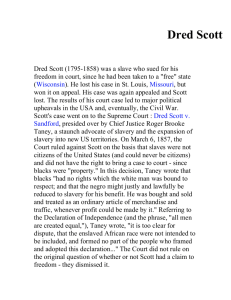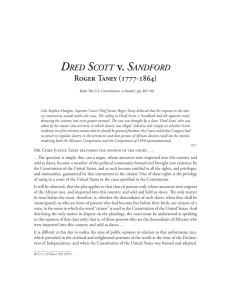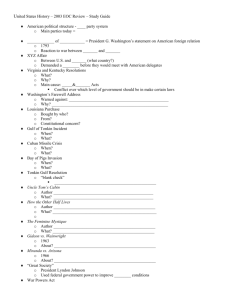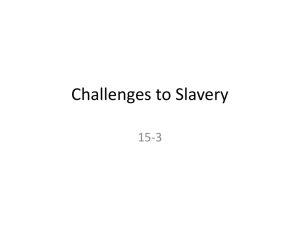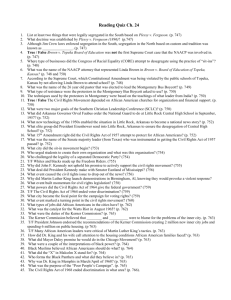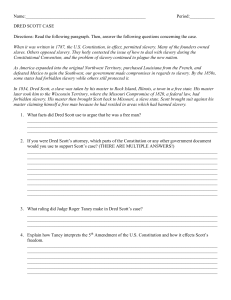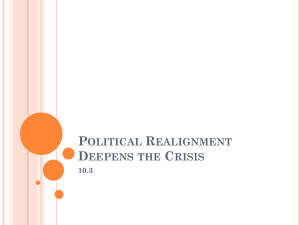DBQ Supreme Court Cases Relating to Civil Liberties for African
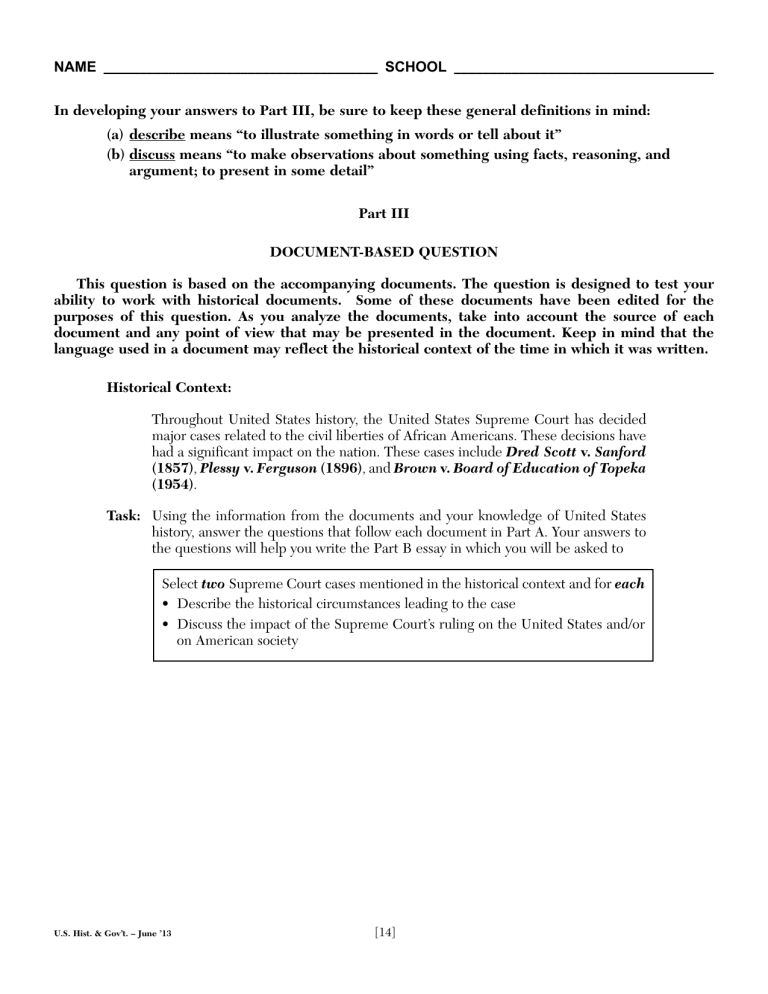
NAME ______________________________________ SCHOOL ____________________________________
In developing your answers to Part III, be sure to keep these general definitions in mind:
(a) describe means “to illustrate something in words or tell about it”
(b) discuss means “to make observations about something using facts, reasoning, and argument; to present in some detail”
Part III
DOCUMENT-BASED QUESTION
This question is based on the accompanying documents. The question is designed to test your ability to work with historical documents. Some of these documents have been edited for the purposes of this question. As you analyze the documents, take into account the source of each document and any point of view that may be presented in the document. Keep in mind that the language used in a document may reflect the historical context of the time in which it was written.
Historical Context:
Throughout United States history, the United States Supreme Court has decided major cases related to the civil liberties of African Americans. These decisions have had a significant impact on the nation. These cases include Dred Scott v.
Sanford
(1857) , Plessy v.
Ferguson (1896) , and Brown v.
Board of Education of Topeka
(1954) .
Task: Using the information from the documents and your knowledge of United States history, answer the questions that follow each document in Part A. Your answers to the questions will help you write the Part B essay in which you will be asked to
Select two Supreme Court cases mentioned in the historical context and for each
• Describe the historical circumstances leading to the case
• Discuss the impact of the Supreme Court’s ruling on the United States and/or on American society
U.S. Hist. & Gov’t. – June ’13
[14]
Part A
Short-Answer Questions
Directions: Analyze the documents and answer the short-answer questions that follow each document in the space provided.
Document 1a
Missouri Compromise of 1820
OREGON
COUNTRY
Occupied by U.S.
and Great Britain
CANADA
Closed to slavery by Missouri
Compromise
M ich igan
Terr.
MISSOURI
SP
AN
COMPROMISE LINE,
36 ° 30'
ISH
TER
RITOR
Y
Admitted as slave state
1821
MO
Arkansas Terr.
LA
IL
MS
IN
TN
KY
AL
OH
GA
Admitted as free state
1820
ME
PA
NY
VT
NH
NJ
RI
CT
MA
DE
MD
VA
SC
NC
Flo rid a
T e rr.
Slave Free
Source: http://voteview.com, University of California, San Diego (adapted)
Document 1b
… After the Missouri crisis it was no longer possible to pretend that the United States was a single nation with a single set of national interests. Although politicians in both North and South worked hard over the next two decades to suppress the issue of slavery in the national debate lest it drive a deeper wedge between the northern and southern wings of both national parties, the society of slaveholders would henceforth be in conflict with the society of free labor.…
Source: Robert Kagan, Dangerous Nation: America’s Foreign Policy from Its Earliest Days to the Dawn of the Twentieth Century , Alfred A. Knopf, 2006
1 Based on these documents, what were two effects the Missouri Compromise had on the nation? [ 2 ]
(1)__________________________________________________________________________________
__________________________________________________________________________________
Score
(2)__________________________________________________________________________________
__________________________________________________________________________________
Score
U.S. Hist. & Gov’t. – June ’13
[15] [OVER]
Document 2
Chief Justice Roger Taney wrote the majority opinion in the Dred Scott case.
… Taney’s decision, which represented the entire Court, not only affirmed the repeal of the
Missouri Compromise that had been achieved by the Kansas-Nebraska Act but also challenged the concept of popular sovereignty in any Western territory. As Southern Senator John C. Calhoun had argued, Taney stated that any move to block the rights of slaveholders to own slaves in a territory violated the due process clause of the Fifth Amendment. Supporters of slavery rejoiced at the decision, while those opposed to the expansion of slavery saw Taney’s work as further evidence that national politics was firmly under the control of Southern apologists [defenders of slavery].
In the end, the Dred Scott case only fueled the already growing flames of sectional mistrust.…
Source: Jeffrey W. Coker, Presidents from Taylor Through Grant, 1849–1877:
Debating the Issues in Pro and Con Primary Documents , Greenwood Press, 2002
2 According to Jeffrey W. Coker, what was one impact of the Dred Scott decision? [ 1 ]
Score
U.S. Hist. & Gov’t. – June ’13
[16]
Document 3a
This is an excerpt from a speech by Frederick Douglass in which he analyzed and criticized the Supreme
Court’s Dred Scott decision.
… This infamous [ Dred Scott ] decision of the Slaveholding wing of the Supreme Court maintains that slaves are within the contemplation [meaning] of the Constitution of the United
States, property; that slaves are property in the same sense that horses, sheep, and swine are property; that the old doctrine that slavery is a creature of local law is false; that the right of the slaveholder to his slave does not depend upon the local law, but is secured wherever the
Constitution of the United States extends; that Congress has no right to prohibit slavery anywhere; that slavery may go in safety anywhere under the star-spangled banner; that colored persons of African descent have no rights that white men are bound to respect; that colored men of African descent are not and cannot be citizens of the United States.…
Source: Frederick Douglass, Speech on the Dred Scott Decision, May 1857
3 a According to Frederick Douglass, what would be one impact of the Dred Scott decision? [ 1 ]
Score
Document 3b
… The third story [of Dred Scott ] is about the politics of slavery and the coming of the Civil War.
The Supreme Court decision sparked enormous political reaction, particularly in the North. It destroyed any chance of agreement between the North and the South over slavery in the territories. It would be an exaggeration to say that the Dred Scott decision caused the Civil War.
But it certainly pushed the nation far closer to that war. The decision played a decisive role in the emergence of Abraham Lincoln as the Republican Party’s presidential candidate in 1860 and his election later that year. That in turn set the stage for secession and civil war.…
Source: Paul Finkelman, Dred Scott v. Sandford [Sanford] : A Brief History with Documents, Bedford Books, 1997
3 b According to Paul Finkelman, what was one effect of the Dred Scott decision on the nation? [ 1 ]
Score
U.S. Hist. & Gov’t. – June ’13
[17] [OVER]
Document 4
TRANSPORTATION OF PASSENGERS.
Act III, 1890, p. 152
… SECTION 1. Separate Accommodations, etc.
—That all railway companies carrying passengers in their coaches in this State, shall provide equal but separate accommodations for the white, and colored [African American] races, by providing two or more passenger coaches for each passenger train, or by dividing the passenger coaches by a partition so as to secure separate accommodations; provided that this section shall not be construed to apply to street railroads. No person or persons, shall be permitted to occupy seats in coaches, other than the ones assigned to them on account of the race they belong to.…
Source: Revised Laws of Louisiana , F. F. Hansell & Bro.
4 Based on this document, what was one effect of this Louisiana law on African Americans? [ 1 ]
Score
U.S. Hist. & Gov’t. – June ’13
[18]
Document 5
This is an excerpt from an article written by Booker T. Washington in response to the decision in
Plessy v. Ferguson .
… Now the point of all this article is not to make a complaint against the white man or the “Jim
Crow Car” law, but it is simply to say that such an unjust law injures the white man, and inconveniences the negro [African American]. No race can wrong another race simply because it has the power to do so, without being permanently injured in morals, and its ideas of justice.
The negro can endure the temporary inconvenience, but the injury to the white man is permanent. It is the one who inflicts the wrong that is hurt, rather than the one on whom the wrong is inflicted. It is for the white man to save himself from this degradation that I plead.
If a white man steals a negro’s ballot, it is the white man who is permanently injured.
Physical death comes to the negro lynched—death of the morals—death of the soul—comes to the white man who perpetrates the lynching.…
Source: Louis R. Harlan, ed., The Booker T. Washington Papers, Volume 4: 1895–98 , University of Illinois Press, 1975
5 According to Booker T. Washington, what would be one impact of the Plessy v. Ferguson decision on white society? [ 1 ]
Score
U.S. Hist. & Gov’t. – June ’13
[19] [OVER]
Document 6
Source: Dorothea Lange, photographer,
June 1937, Library of Congress
Source: Marion Post Walcott, photographer,
October 1939, Library of Congress
6 Based on these photographs, what was one impact of the Plessy decision on American society? [ 1 ]
Score
U.S. Hist. & Gov’t. – June ’13
[20]
Document 7a
Per-Pupil Expenditures in Selected Southern States,
1939–1940 School Year
State
Alabama
Arkansas
Florida
Georgia
Louisiana
Mississippi
North Carolina
South Carolina
Texas
Spending per Pupil
White Negro
$47.59
36.87
69.76
55.56
77.11
52.01
46.02
57.33
72.72
$14.63
13.73
26.95
16.95
20.49
7.36
28.30
5.42
28.49
Average $58.69
$18.82
Note: Data are based on average daily attendance.
(Total spending average does not equal the sum of the state averages.)
Source: Jaynes and Williams, eds.,
A Common Destiny: Blacks and American Society,
National Academy Press, 1989 (adapted)
7 a Based on this chart, what was one disadvantage faced by African American students in these southern states in the early 1940s? [ 1 ]
Score
U.S. Hist. & Gov’t. – June ’13
[21] [OVER]
Document 7b
This letter was sent by the Topeka, Kansas, chapter of the NAACP to the national organization.
September 5, 1950
The National Association for the Advancement of Colored People
Legal Department
20 West 40th
New York City 18, New York
Gentlemen:
I represent the legal branch of N.A.A.C.P., of Topeka, Kansas, and I wish to inform your office of the pending controversy existing in the city of Topeka, and elsewhere in the state of Kansas.
The facts are briefly these: The Board of Education of the aforesaid city is maintaining and has maintained a dual system of education for colored and white grade school children. In doing so, the Board is acting under a permissive statute of the state of Kansas.
The white children have several districts; in these districts, some colored children live, and their parents own property in these so-called districts. However, said colored children are prohibited from attending the schools in these districts, and are compelled to leave their home and meet a bus (said bus is provided by the Board of
Education) that carries them, often for long distances, to the various Negro schools.
The parents of the said Negro children are taxed for all of the schools, and the whole thing results in a jim-crow system.…
Very truly yours
Chas. E. Bledsoe
Source: Kansas Historical Society
7 b According to Chas. E. Bledsoe, what was one problem that existed within the Topeka, Kansas, school system in 1950? [ 1 ]
Score
U.S. Hist. & Gov’t. – June ’13
[22]
Document 8a
Lieutenant Colonel Marion Johnson, commander of Arkansas National Guard troops, is pictured turning back a group of African American students seeking to enter Central High School in Little Rock on
September 4, 1957. He said he was acting on orders of Governor Orval Faubus not to admit them.
Source: Arkansas National Guard
Document 8b
Executive Order 10730
PROVIDING ASSISTANCE FOR THE REMOVAL OF AN OBSTRUCTION
OF JUSTICE WITHIN THE STATE OF ARKANSAS
SECTION 2. The Secretary of Defense is authorized and directed to take all appropriate steps to enforce any orders of the United States District Court for the Eastern District of
Arkansas for the removal of obstruction of justice in the State of Arkansas with respect to matters relating to enrollment and attendance at public schools in the Little Rock School
District, Little Rock, Arkansas. In carrying out the provisions of this section, the Secretary of
Defense is authorized to use the units, and members thereof, ordered into the active military service of the United States pursuant to Section 1 of this Order.
DWIGHT D. EISENHOWER
THE WHITE HOUSE
September 24, 1957
Source: Eisenhower Presidential Library & Museum
8 Based on these documents, why did President Dwight D. Eisenhower issue Executive Order 10730? [ 1 ]
U.S. Hist. & Gov’t. – June ’13
[23]
Score
[OVER]
Document 9
What other movements, campaigns or causes did Brown v. Board aid or inspire?
Mike Wenger: The Brown decision, in my opinion, launched the struggle of African Americans over the next decade and one-half for their constitutional rights.
That struggle inspired a number of other movements, including the movement for Mexican farm workers rights led by Cesar Chavez, who formed the United Farm Workers in 1962.
The movements for equal rights for women and for the rights of disabled citizens also can be traced to the civil rights struggles of African Americans, and therefore, to the Brown decision.
Source: Excerpt of interview with Mike Wenger, special consultant to the Joint Center for Political and Economic Studies,
“Brown v. Board Is...,” Teaching Tolerance , Spring 2004 (adapted)
9 According to Mike Wenger, what was one way the ruling in Brown v. Board of Education of Topeka affected
American society? [ 1 ]
Score
U.S. Hist. & Gov’t. – June ’13
[24]
Part B
Essay
Directions: Write a well-organized essay that includes an introduction, several paragraphs, and a conclusion.
Use evidence from at least four documents in your essay. Support your response with relevant facts, examples, and details. Include additional outside information.
Historical Context:
Throughout United States history, the United States Supreme Court has decided major cases related to the civil liberties of African Americans. These decisions have had a significant impact on the nation. These cases include Dred Scott v. Sanford
(1857), Plessy v. Ferguson (1896), and Brown v. Board of Education of Topeka
(1954) .
Task: Using the information from the documents and your knowledge of United States history, write an essay in which you
Select two Supreme Court cases mentioned in the historical context and for each
• Describe the historical circumstances leading to the case
• Discuss the impact of the Supreme Court’s ruling on the United States and/or on American society
Guidelines:
In your essay, be sure to
• Develop all aspects of the task
• Incorporate information from at least four documents
• Incorporate relevant outside information
• Support the theme with relevant facts, examples, and details
• Use a logical and clear plan of organization, including an introduction and a conclusion that are beyond a restatement of the theme
U.S. Hist. & Gov’t. – June ’13
[25]


